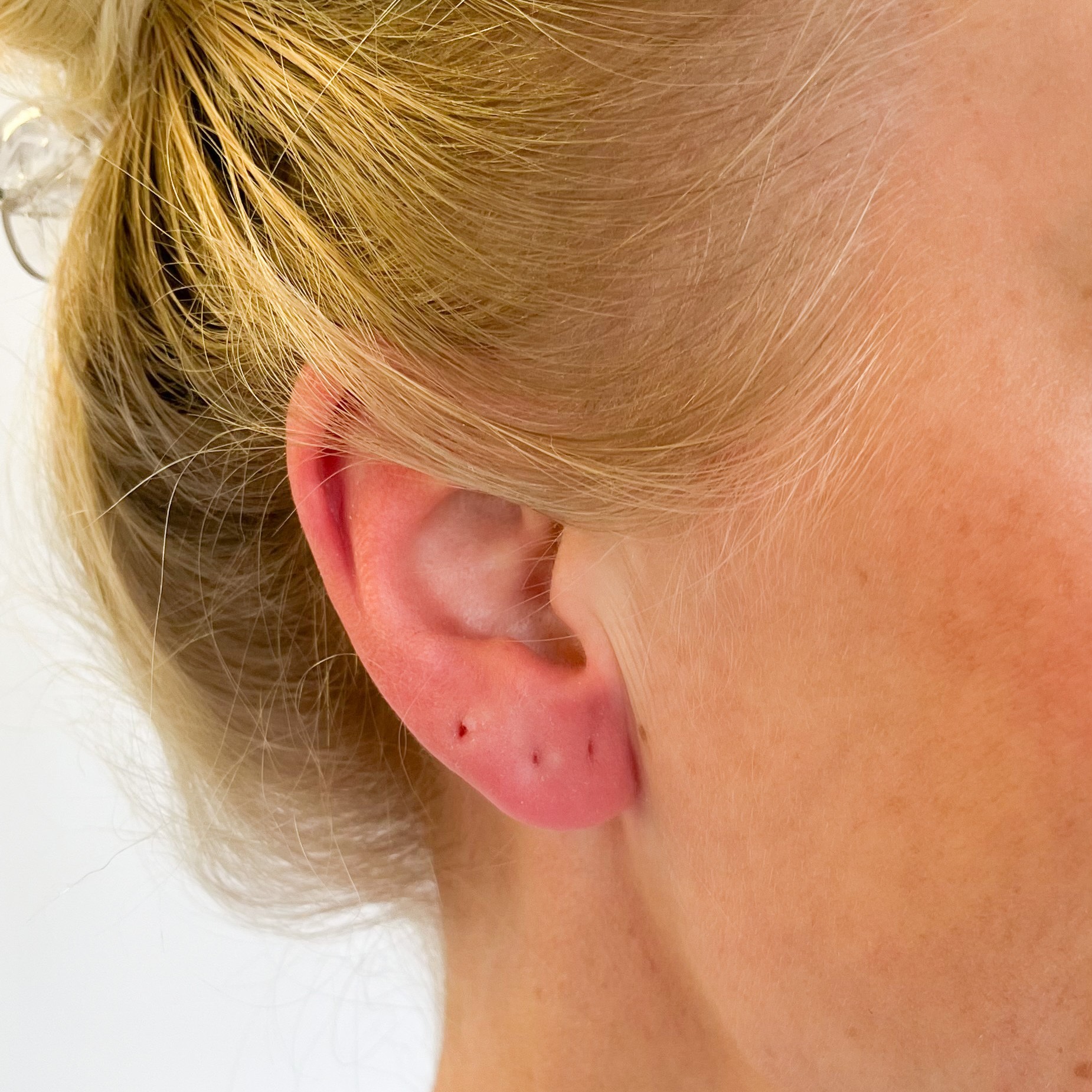Ear Infections from Piercings: What Every Parent Should Know
Hey there, amazing parents! Is your child excited about getting their ears pierced? It’s a big moment! But with great earrings come great responsibilities. Infections can be a part of the ear-piercing journey, and we’re here to make sure you’ve got all the info you need to keep those lobes happy and healthy!
Spot the Signs: Ear Infection Symptoms
First things first, let’s talk prevention by knowing what to look for. An ear infection following a piercing can show up in various ways. Keep an eye out for:
- Redness around the piercing site
- Swelling that doesn’t go down after a few days
- A warm feeling when touching the earlobe
- Yellow or green discharge (not to be confused with normal healing fluids)
- Persistent soreness or pain in the pierced area
- Fever (in some severe cases)
If your child is showing one or more of these symptoms, don’t worry just yet. There are lots of ways to nip these issues in the bud.
Prevention is Key: Ear Care 101
Preventing an ear infection from a piercing is all about good hygiene and care. Here are some tips:
- Ensure the piercing is done at a reputable place that uses sterile equipment. Safety first!
- Follow aftercare instructions to the letter – no shortcuts!
- Encourage your child not to touch the piercing unless they’re cleaning it, and even then, with clean hands only.
- Remind them to avoid swimming or submerging the piercing in water (yes, this includes pool parties and beach outings) until fully healed.
Choosing the Right Earrings
It might be tempting to put in those super cute earrings right away, but hold up! Make sure the first earrings are made of hypoallergenic materials like:
- Stainless steel
- Titanium
- Genuine gold (14K or higher)
- Nickel-free alloys
These materials are less likely to irritate the skin and cause a reaction that could lead to infection.
So, Should You Clean the Piercing?
Absolutely, yes! But let’s make sure we’re doing it correctly. Here’s a simple step-by-step guide to piercing aftercare:
- Wash your hands thoroughly with soap and water before touching the piercing.
- Use a saline solution or a piercing aftercare product recommended by the professional who did the piercing.
- Apply the solution using a cotton ball or gauze to gently clean around both sides of the earrings. No twisting!
- Pat the area dry with a clean, disposable paper towel.
Remember, keeping the pierced area clean helps prevent bacteria from causing an infection, which could lead to complications.
Treatment Time: When to Seek Professional Advice
If you’ve noticed any of the above symptoms and they don’t seem to improve with proper care, or if they get worse, it’s time to seek professional advice. A visit to your pediatrician or a dermatologist can provide some peace of mind and the right treatment path.
Depending on the severity of the infection, treatments can include:
- Topical antibiotic creams or ointments to battle localized infection
- Oral antibiotics for more severe or spreading infections
- Professional removal of the earring by a healthcare provider if the infection is significant
In rare cases, a severe infection might require more intensive treatment, so don’t hesitate to reach out for medical assistance if you’re concerned.
Getting your child’s ears pierced is supposed to be fun and exciting, and, with the right care, it’s generally a safe and smooth process. But, by understanding the risks and knowing how to handle them, you can ensure that ear piercings lead to smiles, not frowns. Keep those little ears happy!
Stay tuned as we dive deeper into the nuances of ear-piercing aftercare, explore more in-depth treatments for infections, and answer all the questions you might have about this common childhood milestone. We’ve got your back—and your little ones’ ears too! Let’s ensure those piercings only bring joy and fabulous style to your child’s life!

Five Things Parents Should Know in Preparing for Ear Infection from Piercing
Preparation is as important as the piercing itself! Here are five essential things to keep in mind:
- Choose the Right Time: Consider your child’s current health and daily activities. Avoid piercings during school sports seasons or right before a vacation where water activities are involved, as this can increase the risk of infection.
- Education is Power: Educate your child about the importance of piercing aftercare. Make it fun and engaging so they understand it’s part of the process of growing up and caring for their own bodies.
- Piercing Provider Matters: Research and choose a piercing studio that comes highly recommended and maintains high hygiene standards. Don’t be afraid to ask questions about their sterilization process and aftercare support.
- Create a Cleaning Routine: Establish a cleaning routine that fits into your child’s daily schedule. For example, cleaning their piercings after brushing their teeth can create a routine that’s easy to remember and stick to.
- Be Prepared for the Unexpected: Have a plan in case of infection. Know where your nearest pediatrician or dermatologist is located and how to quickly get an appointment. Keeping a first-aid kit with sterile saline solution and clean gauze at home is also a great idea.
By arming yourself with these tips and tricks, you can ensure that your child’s piercing experience is as smooth and worry-free as possible. It’s all about planning, education, and being proactive in aftercare!
The Reality of Rejection and Allergies
Sometimes, an ear infection may stem from the body’s reaction to the piercing itself. Known as piercing rejection or an allergic reaction, this occurs when the body doesn’t agree with the jewelry material. Here’s what to look out for:
- Excessive itching around the piercing site
- Earlobe becoming very dry and flaky
- Rash or bumps forming around the piercing
- Earring feeling tight or skin appearing to push the earring out
If you suspect an allergy or rejection, consult with a healthcare provider for the best course of action, which may include swapping out the earrings for ones made from a different material that is hypoallergenic.
Ear Piercing Styles and Their Risks
There are different styles of ear piercings—from the simple lobe to the more complex cartilage piercing. It’s good to know that the risk of infection can vary with the type of piercing. Cartilage piercings, for example, are more complex to heal and carry a higher risk of infection than lobe piercings. Make sure to discuss this with the piercing professional and understand the different care instructions for the specific type of piercing your child wants.
Understanding ear infections from piercings is just a part of parenting in today’s fashion-forward world. But, hey, look at you, all ready to guide your child through it with confidence and cheerfulness! Piercings can be a beautiful expression of personality when done safely and with care, and you’re just the super parent to ensure it’s all smiles and sparkle. Go you!
And remember, knowledge is key! Stay informed, stay alert, and stay smiling. Your child’s ear-piercing adventure awaits, and with this guide, you’re absolutely geared up to make it a success!
If you found this guide helpful, be sure to check out our other family wellness articles packed with tips and tricks for the modern parent. Happy piercing!
For more great articles please see here. For more information see here
Disclaimer
The articles available via our website provide general information only and we strongly urge readers to exercise caution and conduct their own thorough research and fact-checking. The information presented should not be taken as absolute truth, and, to the maximum extent permitted by law, we will not be held liable for any inaccuracies or errors in the content. It is essential for individuals to independently verify and validate the information before making any decisions or taking any actions based on the articles.




